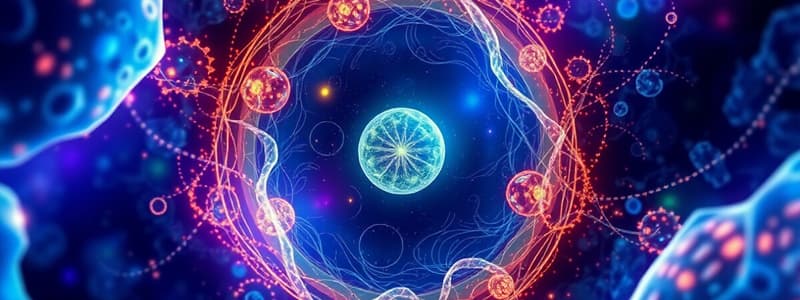Podcast
Questions and Answers
What is a major reason that cells remain small in size?
What is a major reason that cells remain small in size?
- Surface area grows at a faster rate than volume.
- Small cells can move nutrients and waste more efficiently. (correct)
- Small cells have shorter lifespans.
- Smaller cells can contain more DNA.
Which of the following is NOT a part of the cell cycle?
Which of the following is NOT a part of the cell cycle?
- Cytokinesis
- S Phase
- Cell Fusion (correct)
- Mitosis
What differentiates plant cells from animal cells?
What differentiates plant cells from animal cells?
- Animal cells have a cell membrane.
- Both have ribosomes.
- Plant cells have mitochondria.
- Only plant cells have chloroplasts and a cell wall. (correct)
How do mutations contribute to evolution?
How do mutations contribute to evolution?
What is one key observation made by Darwin regarding island animals?
What is one key observation made by Darwin regarding island animals?
Flashcards
What is the cell membrane?
What is the cell membrane?
The cell membrane is a thin layer surrounding every cell. It acts like a gatekeeper, controlling what goes in and out of the cell.
What is cell theory?
What is cell theory?
All living things are made up of cells, cells are the building blocks of life, and new cells come from existing cells.
What is evolution?
What is evolution?
Evolution is the process of change over time in species. It's driven by natural selection, where organisms with traits better suited to their environment survive and reproduce more.
What are mutations?
What are mutations?
Signup and view all the flashcards
What is mitosis?
What is mitosis?
Signup and view all the flashcards
Study Notes
Cell Size and Structure
- Cells are small because their volume increases faster than their surface area.
- Small cells more efficiently move nutrients and waste.
- Cell size is limited by surface area-to-volume ratio, material movement, and DNA efficiency.
Cell Cycle
- S phase: DNA replicates.
- Mitosis: The nucleus divides.
- Cytokinesis: The cell divides into two.
Cell Theory
- All living things are made of cells.
- Cells are the fundamental unit of life.
- New cells arise from existing cells.
Cell Types
- Plant cells have a cell wall and chloroplasts.
- Animal cells do not have these structures.
- Both plant and animal cells contain cell membranes and mitochondria.
Cell Membrane
- Made of fats with water-loving heads and water-fearing tails.
- Controls what enters and exits the cell.
Protein Production
- Ribosomes synthesize proteins.
- The Golgi apparatus packages proteins.
Evolution and Natural Selection
- Species change over time due to natural selection.
- Example: Birds with longer beaks survive if food is deep in trees.
Speciation
- Geographic isolation occurs when a barrier separates a group.
- Reproductive isolation develops when groups stop interbreeding.
Mutations
- Mutations are changes in DNA.
- Mutations drive evolution by creating variation.
Darwin's Observations
- Island animals resemble mainland relatives but adapt to their new environments.
Classification and Characteristics of Life
- Scientific names (e.g., Felis catus) classify organisms.
- Archaea and bacteria are single-celled, with differences in cell walls.
- Characteristics common to all life forms:
- Composed of cells.
- Respond to surroundings.
- Grow, reproduce, and use energy.
- Kingdom distinctions:
- Animals move and cannot produce their own food.
- Plants remain stationary and generate food using sunlight.
Studying That Suits You
Use AI to generate personalized quizzes and flashcards to suit your learning preferences.




